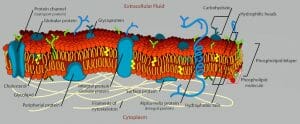Water is essential for life and the dominant fluid in the human body. Water comprises about 75% of body weight in children, 55% in adults, and 45% in old age. The movement of water in and out of cells through a semipermeable membrane (osmosis) is a passive process that doesn’t require energy and is controlled by the number of dissolved solids, or solute, in the fluids.
Intracellular Fluid (ICF)
The fluid inside of cells, also called the cytoplasm or cytosol, makes up about 60% of the water in the human body, totaling about 7 gallons. Organelles like the nucleus, endoplasmic reticulum, mitochondria, lysosomes, and Golgi apparatus are suspended in and supported by the ICF. Also found in the ICF are cellular building blocks like sugars, proteins, carbohydrates, and lipids.
Extracellular Fluid (ECF)
ECFs are any body fluids that are not inside cells. The two main components of ECF are plasma and interstitial fluid (IF). The balance consists of cerebrospinal fluid, lymph, the synovial fluid in the joints, pleural fluid in the pleural cavities (lungs), pericardial fluid around the heart, peritoneal fluid in the peritoneal cavity (abdomen), and the aqueous humor of the eye. In mammals, milk is also considered an extracellular fluid.
The Movement of Solutes Between Compartments
The ICF has higher amounts of potassium, phosphate, magnesium, and protein compared to the ECF. The plasma has high concentrations of sodium, chloride, and bicarbonate, but lower levels of protein as compared to the ICF. While water moves passively via osmosis, sodium and potassium ions move in and out of cells using active transport ion pumps. The pumps are powered by adenosine triphosphate (ATP) to provide the energy to move the ions against their concentration gradients (i.e. sodium moves out of the cell and potassium is pumped in) and maintain the gradients inside and outside the cell.

The image above shows the composition of the cell membrane that separates the extracellular fluid of a cell from the intracellular fluid (cytoplasm).
References
- Body Fluids and Fluid Compartments | Anatomy and Physiology II. (n.d.). Retrieved April 30, 2018, from https://courses.lumenlearning.com/suny-ap2/chapter/body-fluids-and-fluid-compartments-no-content/
Intracellular Fluid vs Extracellular Fluid
No comments:
Post a Comment